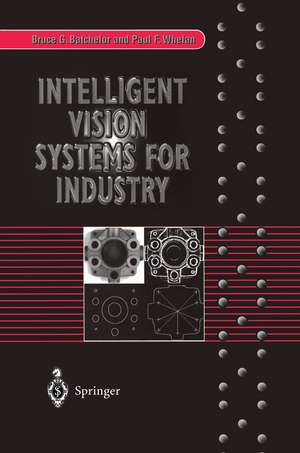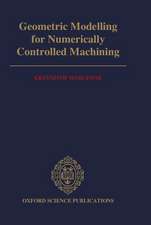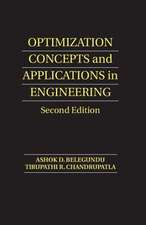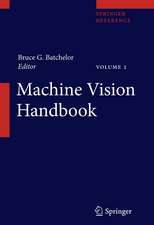Intelligent Vision Systems for Industry
Autor Bruce G. Batchelor, Paul F. Whelanen Limba Engleză Paperback – 10 oct 2012
| Toate formatele și edițiile | Preț | Express |
|---|---|---|
| Paperback (1) | 996.07 lei 6-8 săpt. | |
| SPRINGER LONDON – 10 oct 2012 | 996.07 lei 6-8 săpt. | |
| Hardback (1) | 1002.52 lei 6-8 săpt. | |
| SPRINGER LONDON – 29 apr 1997 | 1002.52 lei 6-8 săpt. |
Preț: 996.07 lei
Preț vechi: 1245.09 lei
-20% Nou
Puncte Express: 1494
Preț estimativ în valută:
190.60€ • 199.41$ • 158.33£
190.60€ • 199.41$ • 158.33£
Carte tipărită la comandă
Livrare economică 02-16 aprilie
Preluare comenzi: 021 569.72.76
Specificații
ISBN-13: 9781447111405
ISBN-10: 1447111400
Pagini: 480
Ilustrații: XXI, 457 p.
Dimensiuni: 155 x 235 x 25 mm
Greutate: 0.67 kg
Ediția:Softcover reprint of the original 1st ed. 1997
Editura: SPRINGER LONDON
Colecția Springer
Locul publicării:London, United Kingdom
ISBN-10: 1447111400
Pagini: 480
Ilustrații: XXI, 457 p.
Dimensiuni: 155 x 235 x 25 mm
Greutate: 0.67 kg
Ediția:Softcover reprint of the original 1st ed. 1997
Editura: SPRINGER LONDON
Colecția Springer
Locul publicării:London, United Kingdom
Public țintă
ResearchDescriere
The application of intelligent imaging techniques to industrial vision problems is an evolving aspect of current machine vision research. Machine vision is a relatively new technology, more concerned with systems engineering than with computer science, and with much to offer the manufacturing industry in terms of improving efficiency, safety and product quality. Beginning with an introductory chapter on the basic concepts, the authors develop these ideas to describe intelligent imaging techniques for use in a new generation of industrial imaging systems. Sections cover the application of AI languages such as Prolog, the use of multi-media interfaces and multi-processor systems, external device control, and colour recognition. The text concludes with a discussion of several case studies that illustrate how intelligent machine vision techniques can be used in industrial applications.
Cuprins
1 Basic Concepts.- 1.1 Industrial Vision Systems.- 1.1.1 Justification.- 1.1.2 Limitations of Present Systems.- 1.1.3 Flexible Manufacturing Systems.- 1.1.4 Process Control.- 1.2 Systems Engineering.- 1.2.1 Importance of Context.- 1.2.2 Industrial Examples.- 1.3 Intelligent Vision.- 1.3.1 Heuristics and Algorithms.- 1.3.2 Artificial Intelligence (AI) Languages.- 1.4 Book Outline.- 2 Basic Machine Vision Techniques.- 2.1 Representations of Images.- 2.2 Elementary Image Processing Functions.- 2.2.1 Monadic, Point-by-point Operators.- 2.2.2 Dyadic, Point-by-point Operators.- 2.2.3 Local Operators.- 2.2.4 Linear Local Operators.- 2.2.5 Non-linear Local Operators.- 2.2.6 N-tuple Operators.- 2.2.7 Edge Effects.- 2.2.8 Intensity Histogram.- 2.3 Binary Images.- 2.3.1 Measurements on Binary Images.- 2.3.2 Shape Descriptors.- 2.4 Binary Mathematical Morphology.- 2.4.1 Opening and Closing Operations.- 2.4.2 Structuring Element Decomposition.- 2.5 Grey Scale Morphology.- 2.6 Global Image Transforms.- 2.6.1 Hough Transform.- 2.6.2 Two-dimensional Discrete Fourier Transform.- 2.7 Texture Analysis.- 2.7.1 Statistical Approaches.- 2.7.2 Co-occurrence Matrix Approach.- 2.7.3 Structural Approaches.- 2.7.4 Morphological Texture Analysis.- 2.8 Implementation Considerations.- 2.8.1 Morphological System Implementation.- 2.9 Commercial Devices.- 2.9.1 Plug-in Boards: Frame-stores.- 2.9.2 Plug-in Boards: Dedicated Function.- 2.9.3 Self-contained Systems.- 2.9.4 Turn-key Systems.- 2.9.5 Software.- 2.10 Further Remarks.- 3 Intelligent Image Processing.- 3.1 Interactive Image Processing.- 3.1.1 Modus Operandi.- 3.1.2 Prototyping Inspection Systems.- 3.1.3 Building Simple Programs.- 3.1.4 Interaction and Prolog.- 3.2 Introducing PrologH-.- 3.3 Review of Prolog.- 3.3.1 Sample Program.- 3.3.2 Sample Queries.- 3.4 The Nature of Prolog+.- 3.5 Prolog+Programs.- 3.5.1 Recognising Bakewell Tarts.- 3.5.2 Recognising Printed Letters.- 3.5.3 Identifying Table Cutlery.- 3.5.4 Analysing all Visible Objects.- 3.5.5 Recognising a Table Place Setting.- 3.6 Abstract Concepts in Prolog+.- 3.6.1 Describing a Simple Package.- 3.6.2 Abstract Spatial Relationships.- 3.6.3 Geometric Figures.- 3.7 Implementation of Prolog+.- 3.7.1 The # Operator.- 3.8 Comments.- 4 Enhanced Intelligent Systems.- 4.1 Prolog+ Environment: A Tool-box for Machine Vision.- 4.1.1 Defining New Predicate Names.- 4.1.2 Default Values for Arguments.- 4.1.3 Useful Operators.- 4.1.4 Program Library.- 4.1.5 Auto-start.- 4.1.6 Interactive Mode.- 4.1.7 User Extendible Pull-down Menus.- Mechanism for Extending Menus.- 4.1.8 Command Keys.- 4.1.9 Graphical Display of a Robot Work Cell.- 4.1.10 Speech Synthesis and Recorded Speech.- 4.1.11 On-line HELP.- 4.1.12 Cursor.- 4.1.13 Automatic Script Generation and Optimisation.- 4.1.14 Linking to Other Programs.- HyperCard Controller for a Flexible Inspection Cell.- 4.2 Understanding Simple Spoken Instructions.- 4.2.1 Speech Recognition.- 4.2.2 Natural Language Understanding.- 4.2.3 Automatically Building a Pull-down Menu.- 4.2.4 Understanding NL Commands for an (X, Y, &3x03D6;)-table.- 4.2.5 Sample Sentences.- 4.2.6 Interpreting the Parser Output.- 4.2.7 Review.- 4.3 Aids for Designing Vision Systems.- 4.3.1 Lighting Advisor.- Stack Structure.- Search Mechanisms.- Remarks About the Lighting Advisor.- 4.3.2 Other Design Aids for Machine Vision.- 4.4 Multi-camera Systems.- 4.4.1 Multiplexed-video Systems.- 4.4.2 Networked Vision Systems.- 4.4.3 Master-Slave System Organisation.- 4.4.4 Remote Queries.- Interactive Operation of the Remote Process.- 4.4.5 Blackboard.- Master and Slave Program Elements.- 4.4.6 Controlling the Master-Slave System.- Starting the System.- Stopping a Slave.- Passing a Message to the Slave.- Receiving Data from a Slave.- Slave Program.- Blackboard (Snapshot of Database, Changing Constantly).- 4.4.7 Crash Recovery.- Programming the Slave from the Master.- 4.5 Comments.- 5 Controlling External Devices.- 5.1 Devices and Signals.- 5.2 Protocols and Signals.- 5.2.1 Interfacing to Commercial Systems.- 5.3 Programmable Logic Controller.- 5.4 General Purpose Interface Unit.- 5.4.1 Motivation for the Design.- 5.4.2 Hardware Organisation.- 5.4.3 Programs.- 5.4.4 Digression on Lighting.- 5.4.5 Languages for Robotics.- 5.5 Flexible Inspection Cell, Design Issues.- 5.5.1 Lighting Arrangement.- 5.5.2 Mechanical Handling.- 5.5.3 Cameras and Lenses.- 5.5.4 MMB-Host Interface Protocol.- 5.5.5 Additional Remarks.- 5.5.6 HyperCard Control Software for the FIC.- 5.6 Prolog+ Predicates for Device Control.- 5.7 System Calibration.- 5.7.1 FIC Calibration Procedure (Overhead Camera).- 5.7.2 Calibration, SCARA and Gantry Robots (Overhead Camera).- 5.7.3 Calibration Procedure (Overhead Narrow-view Camera).- 5.7.4 Calibration Procedure (Side Camera).- 5.8 Picking up a Randomly Placed Object (Overhead Camera).- 5.8.1 Program.- 5.9 Grippers.- 5.9.1 Suction Gripper.- 5.9.2 Magnetic Gripper.- 5.9.3 Multi-Finger Gripper.- 5.9.4 Further Remarks.- 5.10 Summary.- 6 Colour Image Recognition.- 6.1 Introduction.- 6.2 Applications of Coarse Colour Discrimination.- 6.3 Why is a Banana Yellow?.- 6.4 Machines for Colour Discrimination.- 6.4.1 Optical Filters.- 6.4.2 Colour Cameras.- 6.4.3 Light Sources for Colour Vision.- 6.4.4 Colour Standards.- 6.5 Ways of Thinking about Colour.- 6.5.1 Opponent Process Representation of Colour.- 6.5.2 YIQ Colour Representation.- 6.5.3 HSI, Hue Saturation and Intensity.- 6.5.4 RGB Colour Space: Colour Triangle.- 6.5.5 1-Dimensional Histograms of RGB Colour Separations.- 6.5.6 2-Dimensional Scattergrams.- 6.5.7 Colour Scattergrams.- 6.6 Programmable Colour Filter (PCF).- 6.6.1 Implementation of the PCF.- 6.6.2 Programming the PCF.- 6.6.3 Recognising a Single Colour.- 6.6.4 Noise Effects.- 6.6.5 Recognising Multiple Colours.- 6.6.6 Pseudo-Colour Display for the PCF.- 6.6.7 Recent Teaching of the PCF Dominates.- 6.6.8 Prolog+Software for Operating the PCF.- Plot Colour Scattergram.- Draw Colour Triangle Outline.- Clear LUT.- Store Current LUT.- Reload Stored PCF.- Reverting to Monochrome Operation.- 6.6.9 Programming the PCF using the Colour Scattergram.- 6.6.10 Programming the PCF by Image Processing.- 6.6.11 “Hue” PCF.- 6.6.12 Analysing Output of the Hue PCF.- 6.6.13 “Segmented” PCF.- 6.6.14 Measuring Colour Similarity and Saturation.- 6.6.15 Detecting Local Colour Changes.- 6.6.16 Colour Generalisation.- 6.7 Colour Recognition in Prolog+ Programs.- 6.7.1 Counting Coloured Objects.- 6.7.2 Recognising a Polychromatic Logo, Program 1.- 6.7.3 Recognising a Polychromatic Logo, Program 2.- 6.7.4 Recognising a Polychromatic Logo, Program 3.- 6.7.5 Multiple Exemplar Approach to Recognition.- 6.7.6 Learning Proportions of Colours in a Scene.- 6.7.7 Superior Program for Learning Colour Proportions.- 6.7.8 Teaching the PCF by Showing.- 6.7.9 Template Matching of Colour Images.- 6.7.10 Using Colour for Object Orientation.- 6.7.11 Approximating an Image by a Set of Overlapping Discs.- 6.7.12 Interpreting Resistor and Capacitor Colour Codes.- 6.8 Discussion and Conclusions.- 7 Applications of Intelligent Vision.- 7.1 Recognition of Printed Patterns.- 7.1.1 Non-picture Playing Cards.- 7.1.2 “Stars”.- 7.1.3 “Smiley Faces”.- 7.1.4 Alphanumeric Characters.- Program.- Comments.- Logical and Analogue Shape Measurements.- 7.2 Manipulation of Planar Objects.- 7.2.1 Assumptions.- 7.2.2 Significance.- 7.2.3 Simple Shape Measurements.- 7.2.4 Learning and Recognition.- 7.2.5 Program Listing.- 7.2.6 Sample Output of Recognition Phase.- 7.3 Packing and Depletion.- 7.3.1 Geometric Packer Implementation.- 7.3.2 Heuristic Packing Techniques.- Blob Packing.- Polygon Packing.- 7.3.3 Performance Measures.- Predicates.- 7.3.4 Robot Gripper Considerations.- 7.3.5 Packing Scenes with Defective Regions.- 7.3.6 Discussion.- 7.4 Handedness of Mirror-Image Components.- 7.4.1 Handedness and Chirality.- Relating Chirality and Handedness.- 7.4.2 Concavity Trees.- Formal Definition.- Generating Concavity Trees.- Sample Concavity Trees.- Canonical Form of Concavity Trees.- Program to find Chirality.- 7.4.3 Properties of Concavity Trees.- Instability.- 7.4.4 Simpler Tests for Chirality.- Second Program.- Third Program.- Fourth Program.- Fifth Program.- 7.5 Telling the Time.- 7.5.1 Significance.- 7.5.2 Simplifying Assumptions.- 7.5.3 Lighting.- 7.5.4 First Program.- 7.5.5 Other Methods.- 7.5.6 Concluding Remarks.- 7.6 Food and Agricultural Products.- 7.6.1 Objective.- 7.6.2 Industrial Relevance.- 7.6.3 Product Shape, Two-dimensions.- Image Acquisition.- Rectangular and Circular Biscuits.- Slices of Bread.- Locating the Base and Determining Orientation.- Locating Straight Sides.- Measuring Overspill.- Radius of Curvature of Top Edge.- 7.6.4 Analysing the 3D Structure of an Uncut Loaf.- 8 Concluding Remarks.- References.- A Proverbs, Opinions and Folklore.- B Factors to be Considered when Designing a Vision System.- C General Reference Material.- D PIP — Software Implementation of Prolog+.- E Prolog+ and PIP Commands.- Glossary of Terms.- Index of Predicates, Operators and Grammar Rules.















